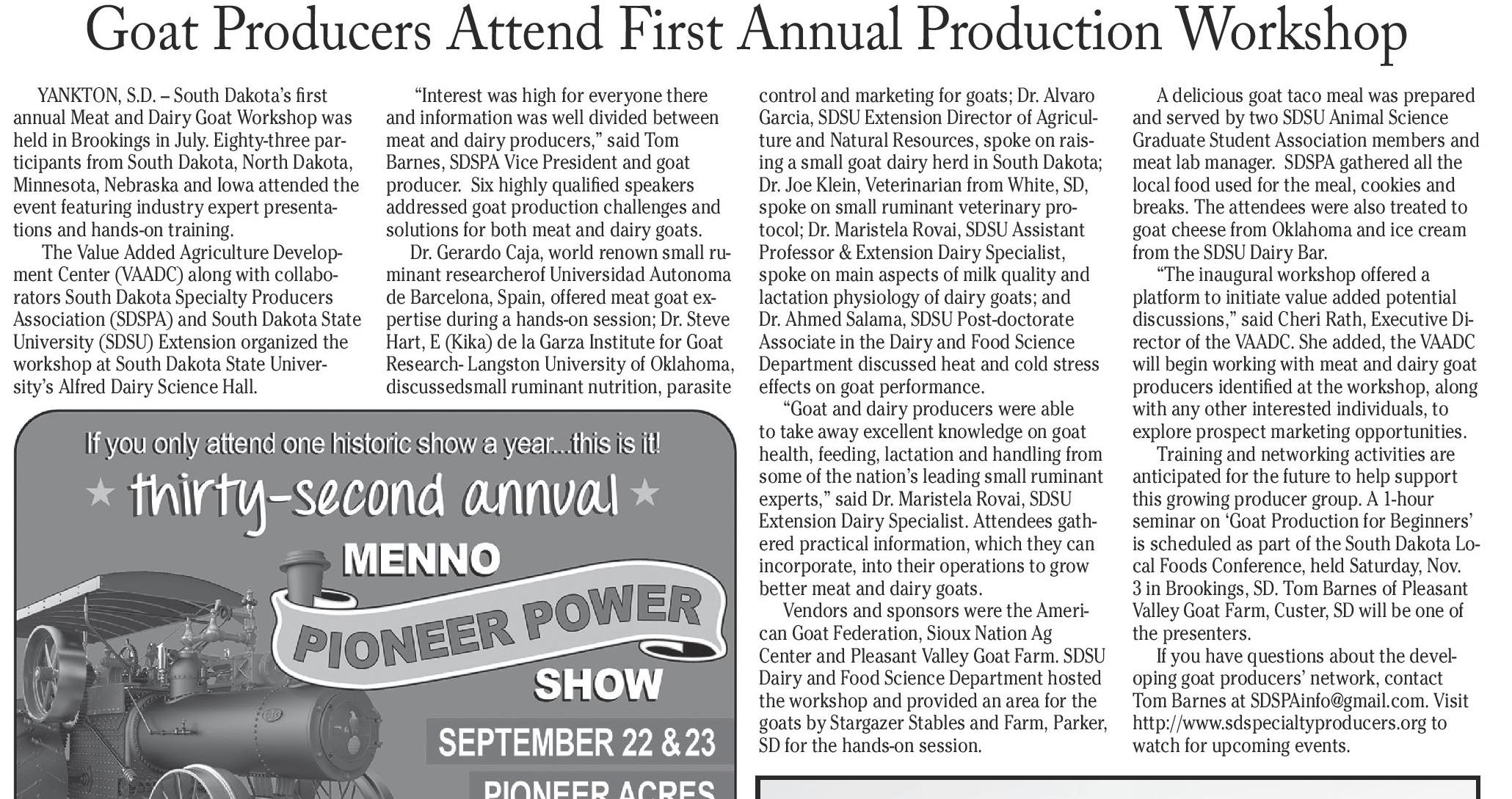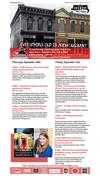091818_YKBP_A8.pdf






8 Broadcaster Press
September 18, 2018 www.broadcasteronline.com
Cultural Heritage Center To Participate In 14th
Annual Smithsonian Magazine Museum Day Event
PIERRE, S.D. -- On Saturday, Sept. 22,
all visitors to the Cultural Heritage Center
in Pierre will be welcomed free of charge
courtesy of Smithsonian magazine.
This is the 14th anniversary of the
event across the nation, and the sixth
since the Museum of the South Dakota
State Historical Society became a Smithsonian Affiliate.
The event represents the Smithsonian’s
commitment to make museums accessible
to everyone across all 50 states by providing free admission to patrons, like the admissions policy of Smithsonian museums
in Washington, D.C. Last year’s event drew
more than 200,000 visitors nationwide,
and 2018 promises to be even bigger.
“We are delighted to participate in this
program with our partners at the Smithsonian and many other museums around the
nation,” said Jay Smith, museum director. “It will be great to see thousands of
people taking advantage of this unique
opportunity to visit some of the best museums in the world, and we are proud to
stand alongside so many of our colleagues
participating in this project.”
The museum at the Cultural Heritage
Center in Pierre became an Affiliate of the
Smithsonian Institution in January 2013.
On Sept. 22, the museum will also be
conducting its annual “Traditional Arts
Day” program with American Indian artists demonstrating their craft activities
from 10 a.m.-4 p.m. CDT. There will also be
a showing of the Smithsonian Channel™
film “Pocahontas: Beyond the Myth” at 11
a.m. and 12:30 p.m.
Visitors to the Museum of the South
Dakota State Historical Society will be
admitted free of charge on Sept. 22, but
if they want to visit other participants
in Museum Day, visitors merely need to
visit Smithsonian.com/museumday, fill out
a short form, and they will receive free
tickets to the Cultural Heritage Center and
other participating institutions.
Museum Day tickets are valid on Sept.
Rising Suicide Rates Require A
Multifaceted Approach To Prevention
PIERRE, S.D. — Suicides rates have been rising in recent years in South Dakota. In 2017, 192 South Dakotans
died by suicide, the most ever reported. Suicide was the
ninth leading cause of death among all South Dakotans
and the second leading cause of death among individuals
15 to 34 years old.
“Suicide is a leading cause of death in South Dakota—
and it’s a tragedy for families and communities across
the state,” said Kim Malsam-Rysdon, Secretary of Health.
“From individuals and communities to employers and
healthcare professionals, everyone can play a role in efforts to help save lives and reverse the current trend.”
Mental health conditions are often seen as the cause
of suicide, but suicide is rarely caused by any single factor. In fact, according to a recent Vital Signs report from
the Centers for Disease Control Prevention (CDC), more
than half of people who die by suicide are not known to
have a diagnosed mental health condition at the time of
death. Other problems often contribute to suicide, such
B oad
as those related torrelationships,eronl use, physical
cast substancee
in . However,
health and job, money, legal or housing stress. com
pinpointing these factors is often difficult.
“Recently, South Dakota was awarded funding from the
CDC to participate in the National Violent Death Reporting System (NVDRS),” said Dr. Joshua Clayton, state epidemiologist. “This new tool will provide us with a clearer
understanding of the circumstances surrounding violent
deaths such as suicide.”
In coming years, data from NVDRS will be used to gain
insight into possible contributing factors to suicide. In
addition, the system will provide communities and organizations with important information to help them develop
and tailor prevention efforts. Starting this fall, all fifty
states now participate in NVDRS, the only state-based
reporting system that collects data on violent deaths and
their circumstances.
South Dakota has resources available to help individuals experiencing suicidal thoughts and support for those
who have lost a loved one to suicide. Individuals in need
of help are encouraged to call the Suicide Prevention
Lifeline at 1-800-273-TALK (8255). Services are available
24/7. Help can also be obtained by contacting any medical provider such as a family physician, psychiatrist or
hospital emergency room, as well as a Community Mental
Health Center or other mental health provider in your
area. If you believe someone is at risk for suicide, contact
a professional immediately.
SDSuicidePrevention.org also provides communities
and individuals with access to local data, prevention
toolkits for specific populations as well as resources
for survivors. For those who have lost a loved one to
suicide, a list of support groups in South Dakota is also
available.
22 only. At the Cultural Heritage Center,
kids 17 and under are always admitted for
free.
“This is a great opportunity to come
out and enjoy Traditional Arts Day,” said
Jay D. Vogt, director of the South Dakota
State Historical Society. “People can also
visit the ‘Spirit of the 70s’ exhibit, which
has proven to be quite popular over the
summer.”
The museum is open from 9 a.m.-4:30
p.m. CDT Monday through Saturday, and
1-4:30 p.m. on Sundays and most holidays.
Call 605-773-3458 for more information
about exhibits, special events and upcoming activities.
Grow In
South Dakota
By Dustin Oedekoven
Interim South Dakota Secretary of Agriculture
Not so long ago, and just before I entered high school,
I was the jubilant recipient of a “Junior Agriculture loan”
from the South Dakota Department of Agriculture. I bought
my first ten bred heifers from a relative, kick-starting a new
chapter in my 4-H career and launching my “S.A.E.” (talk
to your local blue and gold jacket wearing FFA members if
you need a translation). That loan helped to strengthen my
tie to agriculture, just like SDDA loans help young farmers
and ranchers today. It is important to help be a resource
for young agriculturalists to help them get their start and
be the future of agriculture in our state.
Agriculture is woven into South Dakota’s past, and it is
a bright part our future. When agriculture does well, South
Dakota does well. When agriculture struggles, we all struggle. If we will strengthen our agricultural community, we
can strengthen South Dakota. To help with this, the South
Projects must follow the guidelines for Community
2x1
Dakota Department of Agriculture has a team we call our
Forestry Challenge Grants. These guidelines can be
viewed at: https://bit.ly/2NqlKGf. The Challenge Grant ap- Agricultural Development division, who specifically focus
on the growth and promotion of agriculture and agriculplication can be found at: https://bit.ly/2CFzpEZ.
tural products in South Dakota.
A complete submission consists of: the application, a
The Ag Development team focuses on making connecbudget sheet, a supplemental questionnaire, a work plan
and two tree quotes if tree planting funds are requested. tions, bringing people together who are interested in moving ahead with projects, such as adding value to agriculIf you have questions, please contact Rachel Ormseth at
tural products or expanding and creating farms or ranches.
605.280.4854.
Whether awarding more than $300,000 in grants to those
3x1
Agriculture is a major contributor to South Dakota’s
promoting and researching specialty crops in South Dakota
economy, generating $25.6 billion in annual economic
activity and employing over 115,000 South Dakotans. The or providing $3.7 million in assistance to producers and
agribusinesses through finance programs; we strive to a be
South Dakota Department of Agriculture's mission is to
helping hand to those who want to grow in South Dakota.
promote, protect and preserve South Dakota agriculture
Our team is currently working with companies, commufor today and tomorrow. Visit us online at http://sdda.
nities and private individuals on projects with a projected
sd.gov or find us on Facebook, Instagram and Twitter.
value of over $280 million to South Dakota’s economy.
If you would like help with business planning, financial
reviews, technical assistance, pre-feasibility studies, or
other topics related to growing in South Dakota, visit our
website at sdda.sd.gov/ag-development/ or contact our Ag
Development team at 605.773.5436.
Broadcasteronline.c
om
Broadcasteronline.c
om
4x1
Goat Producers Attend First Annual Production Workshop
YANKTON, S.D. – South Dakota’s first
annual Meat and Dairy Goat Workshop was
held in Brookings in July. Eighty-three participants from South Dakota, North Dakota,
Minnesota, Nebraska and Iowa attended the
event featuring industry expert presentations and hands-on training.
The Value Added Agriculture Development Center (VAADC) along with collaborators South Dakota Specialty Producers
Association (SDSPA) and South Dakota State
University (SDSU) Extension organized the
workshop at South Dakota State University’s Alfred Dairy Science Hall.
“Interest was high for everyone there
and information was well divided between
meat and dairy producers,” said Tom
Barnes, SDSPA Vice President and goat
producer. Six highly qualified speakers
addressed goat production challenges and
solutions for both meat and dairy goats.
Dr. Gerardo Caja, world renown small ruminant researcherof Universidad Autonoma
de Barcelona, Spain, offered meat goat expertise during a hands-on session; Dr. Steve
Hart, E (Kika) de la Garza Institute for Goat
Research- Langston University of Oklahoma,
discussedsmall ruminant nutrition, parasite
control and marketing for goats; Dr. Alvaro
Garcia, SDSU Extension Director of Agriculture and Natural Resources, spoke on raising a small goat dairy herd in South Dakota;
Dr. Joe Klein, Veterinarian from White, SD,
spoke on small ruminant veterinary protocol; Dr. Maristela Rovai, SDSU Assistant
Professor & Extension Dairy Specialist,
spoke on main aspects of milk quality and
lactation physiology of dairy goats; and
Dr. Ahmed Salama, SDSU Post-doctorate
Associate in the Dairy and Food Science
Department discussed heat and cold stress
effects on goat performance.
“Goat and dairy producers were able
to take away excellent knowledge on goat
health, feeding, lactation and handling from
some of the nation’s leading small ruminant
experts,” said Dr. Maristela Rovai, SDSU
Extension Dairy Specialist. Attendees gathered practical information, which they can
incorporate, into their operations to grow
better meat and dairy goats.
Vendors and sponsors were the American Goat Federation, Sioux Nation Ag
Center and Pleasant Valley Goat Farm. SDSU
Dairy and Food Science Department hosted
the workshop and provided an area for the
goats by Stargazer Stables and Farm, Parker,
SD for the hands-on session.
A delicious goat taco meal was prepared
and served by two SDSU Animal Science
Graduate Student Association members and
meat lab manager. SDSPA gathered all the
local food used for the meal, cookies and
breaks. The attendees were also treated to
goat cheese from Oklahoma and ice cream
from the SDSU Dairy Bar.
“The inaugural workshop offered a
platform to initiate value added potential
discussions,” said Cheri Rath, Executive Director of the VAADC. She added, the VAADC
will begin working with meat and dairy goat
producers identified at the workshop, along
with any other interested individuals, to
explore prospect marketing opportunities.
Training and networking activities are
anticipated for the future to help support
this growing producer group. A 1-hour
seminar on ‘Goat Production for Beginners’
is scheduled as part of the South Dakota Local Foods Conference, held Saturday, Nov.
3 in Brookings, SD. Tom Barnes of Pleasant
Valley Goat Farm, Custer, SD will be one of
the presenters.
If you have questions about the developing goat producers’ network, contact
Tom Barnes at SDSPAinfo@gmail.com. Visit
http://www.sdspecialtyproducers.org to
watch for upcoming events.
RAISE
YOUR
Expectations.
101 W Main St | 605.624.4461 | CorTrustBank.com
ID 405612

















 Previous Page
Previous Page






